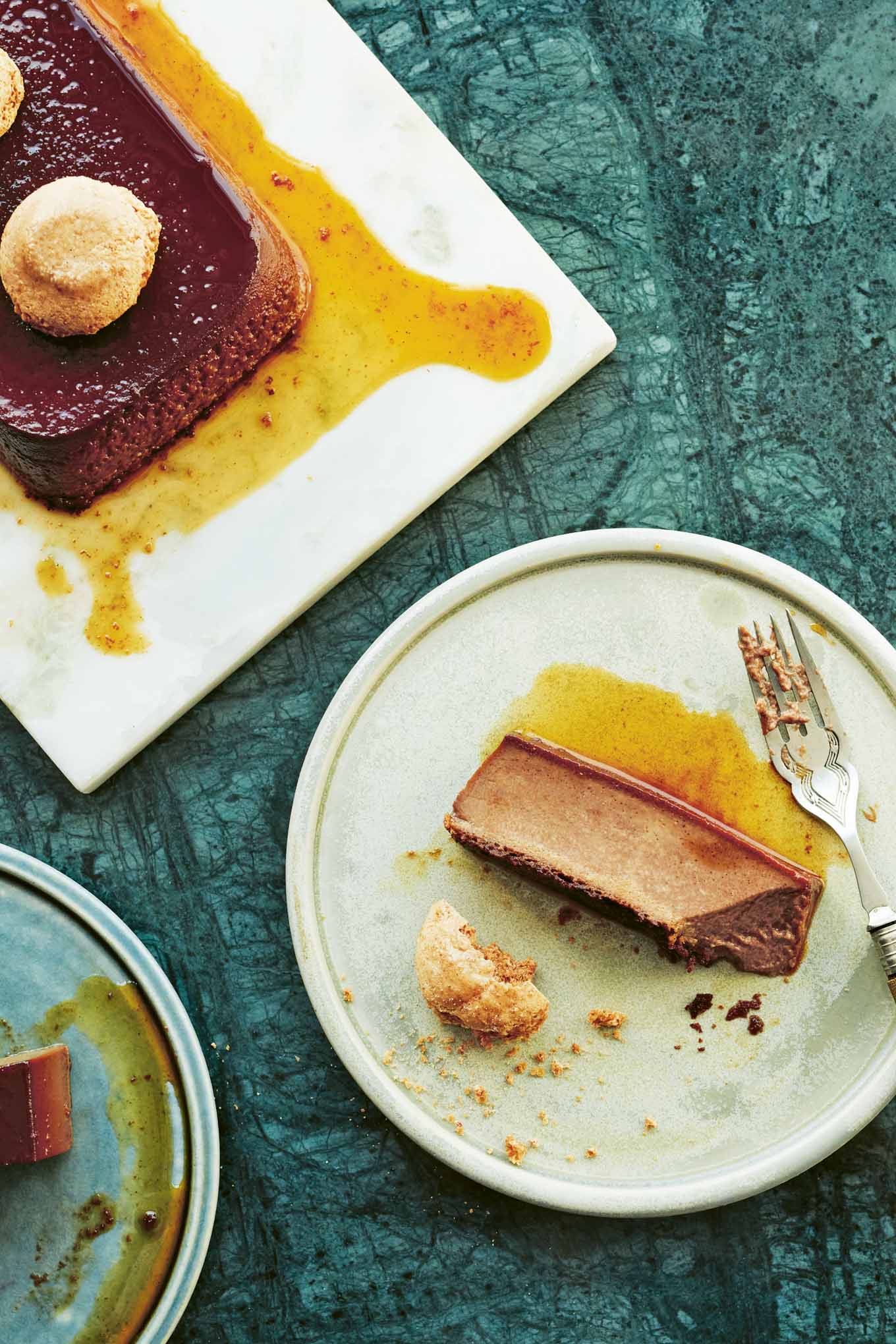
Words by Giuseppe Dell’Anno. Photo by Matt Russell.
Bonèt is an ancient, flan-type dessert named, according to 19th-century literature, after the shape of the pan used to bake it in, resembling a hat, or bonèt in the local dialect. The origins of bonèt are deeply rooted in Piedmont, where it is still a traditional end-of-meal dessert, typical of the Langhe region. Preparation is simple, however, like most crème-caramel-type desserts, bonèt is baked in a bain-marie (water bath), so you will need a large roasting tray, filled with water, in which to accommodate the baking tin. The texture is similar to crème caramel, albeit with slightly more body, due to the biscuits in the batter. The flavour, however, is more robust: bonèt tastes unmistakably of amaretti and the chocolate and liqueur contribute to its bold flavour.
For bonèt, you can use shop-bought amaretti, or make your own. Traditionally, the liqueur added to the batter was Fernet, a quintessentially Italian end-of-meal drink, but amaretto liqueur is much easier to source, and it goes very well with the almond flavour. Rum or cognac are also common alternatives, and a non-alcoholic version can be baked using the same amount of strong espresso instead. Bonèt needs to cool and rest for at least a couple of hours in the fridge before being demoulded, to make sure that it builds its consistency fully. It is the perfect dessert to prepare in advance as it benefits from a whole night in the fridge. Amaretti biscuits are the unmissable decoration, but also a few swirls of sweet whipped cream would go very well with the dense chocolatey texture. Bonèt must be served cold.
Get your copy of Giuseppe’s Italian Bakes here.
Bonèt Piedmontese Pudding
Ingredients
- 120 g (2/3 cup) superfine sugar
- 100 g (3½oz) amaretti biscuits , (shop-bought or homemade, see pages 88–90), plus a few extra to decorate
- 170 g (5¾oz) egg yolk (about 10 medium egg yolks)
- 90 g (½ cup) superfine sugar
- 700 g (3 cups) whole milk
- 50 g (½ cup) unsweetened cocoa powder
- 50 g (generous 3 tbsp) amaretto liqueur (or coffee)
- 1 tsp vanilla bean paste
- ⅛ tsp salt
Instructions
- Place the loaf tin on a flat, heat-resistant surface (a wooden chopping board is ideal). To make the caramel, place a metal pan with the sugar over the lowest heat on your hob and wait for the edges to start melting. At that point, occasionally tilt and shake the pan to melt all the sugar. At no point in the process should you stir the caramel. The caramel is ready as soon as all the sugar is liquid and deep amber in colour. Carefully pour the caramel into the loaf tin and swirl it around to coat the bottom. Leave on the heat-resistant surface to cool.
- Place the shelf in the middle of the oven and preheat it to 180°C (350°F/Gas mark 4).
- Place the amaretti in the bowl of a food processor and blitz them at full speed until they turn into a fine, flour-like powder. Set aside. Place the egg yolks and the sugar in the bowl of a stand mixer fitted with the whisk attachment and whisk them at full speed for 2–3 minutes until pale and fluffy.
- Meanwhile, place the milk in a spouted, stout, microwave-safe jug and microwave it until it is warm to the touch. Two minutes in a conventional 800W oven should be enough.
- When the egg mixture is pale and fluffy, stop the mixer and sift in the cocoa powder, then add the liqueur, vanilla, salt and ground amaretti. Start the mixer at very low speed to combine the ingredients. Finally, add the milk and whisk again until smooth.
- Place the loaf tin into the larger roasting tray and pour the batter into the tin. Place the baking tray and tin in the oven and carefully pour boiling water into the tray up to about three quarters of the height of the tin. Bake for 43–45 minutes. At this stage, the surface of the bonèt will look almost spongy and fully baked, with the edges nearly coming off the sides of the tin. The centre will still have a gentle wobble and the batter will feel quite jelly-like. Do not be tempted to wait for the bonèt to look completely set or it will overbake, resulting in a tough, rubbery texture. Remove the loaf tin from the bain-marie and let it cool to room temperature, then leave it to rest in the fridge for at least a couple of hours, ideally overnight.
- When you are ready to serve, run a blunt knife around the sides of the baking tin, cover it with an upside-down serving plate and turn both over. Tap the plate over a folded dish towel to help the bonèt come out of the tin. The bonèt should slide out easily, but if it refuses to, dip the tin into a hot water bath for a few seconds, then repeat the previous step.
- Decorate the top of the bonèt with a few amaretti biscuits and a few swirls of sweet whipped cream, if you like. Store in the fridge for up to 2–3 days.
Giuseppe’s Italian Bakes by Giuseppe Dell’Anno (Quadrille, £20), Photography © Matt Russell